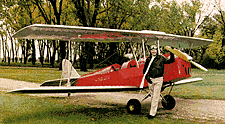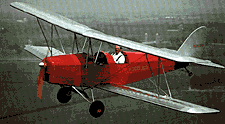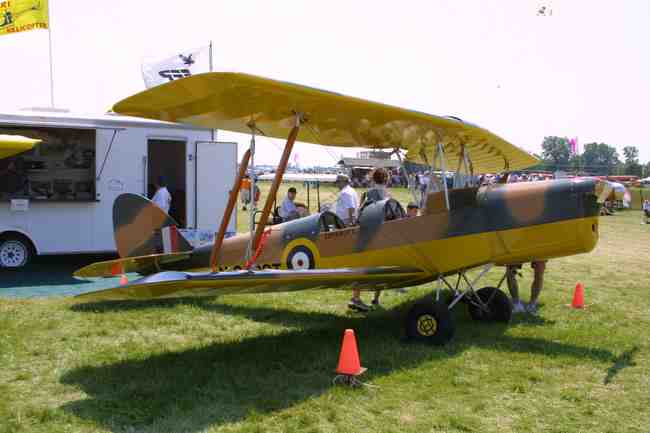|
TIGER MOTH
We fly the Norton-rotary-powered FFP Tiger Moth.
BY BEN MILLSPAUGH
The author looks the part in a leather helmet, flying goggles,
gauntlet gloves and a silk scarf.
The weather couldn't have been better when
I left Denver -- visibility was 75 miles, temperature was 72°F and the
countryside was a rainbow of fall colors. By the time I landed in
Bismarck, North Dakota, the temperature had dropped from Colorado's
mid-seventies to the northern Great Plains mid-forties. One thing was for
sure, though: It was more authentic. The overcast and damp weather was
more like autumn at the Stag Lane Aerodrome in Middlesex, England, where
the original de Havilland Tiger Moth was built.
Gene and Darlene Hanson, owners of Fisher Flying Products (FFP), were
at the Bismarck Airport to pick me up, and from there we drove 140 miles
to their manufacturing facility in Edgeley. This little community is a
classic example of a small town in America's rich agricultural heartland.
From this location, FFP markets a number of well-known kit airplanes. Its
line features the new folding wing Dakota Hawk, the two-place Classic
biplane, and the attractive side-by-side Super Koala. The FFP clan also
includes several proven ultralights such as the FP202, -303. -505, -606
and a single-seat biplane, the -404.
The 1,000-square-foot manufacturing facility has to be one of the most
well-organized operations of its kind. Vacuum extractors keep dust to a
minimum and the plant is squeaky clean. Regardless of the sometimes brutal
North Dakota winters, the shop is maintained at 68°F.
Shortly after I arrived, Virginia Fischer, staff member in charge of
accounting, informed Gene and Darlene that two confirmed orders for FP-202
kits had just come in. That made everyone happy, and it was a cheerful
beginning for my visit. In the shop, design engineer Steve Lambert and
warehouseman Chuck Dathe were helping a telephone customer who was
building a Dakota Hawk. Daine Woehl, assembly technician, was busy trying
to finish a quick-build spar for one of the Classic orders. This was not
your usual Monday-morning type of workplace; no one was complaining.
At 9 a.m., all of the employees took a coffee break. It was also time
for peanut butter, jelly and toast with the Hansons. Was this a North
Dakota tradition that I didn't know about? Having coffee with the boss is
one thing, but peanut butter and jelly? On toast? And it happened twice
that day.
Back in the shop, I was impressed with the quality of equipment and
with the pieces being made. All components were fashioned from
aircraft-grade materials: spruce, aluminum, steel, and AN hardware. Every
wood piece looked as though it had been cut with a new router or a fresh
saw blade. I think this says a lot for the high standards set by the
owners of the company. I also noticed the pride everyone seemed to have in
the FFP products.
Meet the Moth
Our test subject, the R80 (replica 80%) Tiger Moth, is the newest in
the line and is available for a base price of $8500. The quick-build
version goes for $9950. The basic airframe kit contains all the parts
necessary to build a complete aircraft except for paint, wood varnish,
restraint harnesses, instruments and engine. All kit parts are pre-cut,
shaped, and where necessary, slotted. The hardware includes steel,
aluminum, fiberglass and plastic components. Options include Matco wheels,
hydraulic brakes, and a center section, 7.5-gallon auxiliary fuel tank.
The factory prototype has a Norton Rotary engine, but other power plant
options are available, including the Rotax 582 and 618. Also under
consideration is a Subaru conversion. The Norton AEIOOR is a Wankel rotary
with twin rotors. lt has a 588-cc displacement and produces 100 hp at 7000
rpm. lt is liquid-cooled and weighs 117 pounds, dry. Carburation is a dual
Tillotson diaphragm type with a consumption of 0.5 pounds per brake
horsepower per hour at 70% cruise. The Norton has an integrated helical
reduction gear system and a torsional vibration damper with a final ratio
of 1:2.964. Ignition is dual CDI with two plugs per rotor. It has a TBO of
1500 hours.
As the British would say, the "leading particulars" of the
R80 include a span of 23 feet with a total wing area of 170 square feet.
The nose-to-tail length is 19 feet with a height of 7 feet. Empty weight
of the prototype is 560 pounds and stress analysis testing has determined
the gross weight to be 1150 pounds.
The actual DH82a Tiger Moth has a span of 29 feet 4 inches, a length of
23 feet 11 inches, and a height of 8 feet 9.5 inches. The empty weight is
1180 pounds and maximum permissible or gross weight is 1825 pounds.
Initial R80 performance data was based on tests done earlier in 1994
from a smooth grass field. The temperature at the time of testing was 68°F
and the winds were calm. The takeoff distance was consistently 300 feet
and the landing distance was 400 feet. Rate of climb from the 1180-foot
elevation farm strip was determined to be 800 fpm. With a fuel capacity of
12 gallons from a fuselage-mounted tank, the R80 should have a range of
nearly 300 miles. The original DH82a Tiger Moth has a Gipsy Major inline,
four-cylinder engine that produces 130 hp at 2350 rpm. Fuel capacity is
23.6 gallons (19 Imperial).

The Fisher Flying Products Tiger Moth offers a bit of aviation
history in a simple kit aircraft package.
Flying the Moth
The weather remained cloudy and damp throughout my stay in North
Dakota. When the wind finally died down and the ceiling lifted, I got my
chance to fly the airplane. The family farm has a half-mile grass strip
that parallels U.S. Highway 281. Looking around, I was pleased to find it
completely open on the south end with no trees or powerlines. The area
surrounding Edgeley is ideal for testing a new airplane -- umpteen
thousand square miles of landing fields! I like that!
I began thinking of my home base at Greeley Weld County Airport in
Colorado, which has a field elevation of 4660 feet. The Edgeley farm strip
was 3080 feet lower. On a warm summer afternoon, airplane performance in
Colorado diminishes by as much as 25% due to density altitude. My little
Classic biplane, with a Rotax 532, has an effective horsepower of about 50
under those conditions. I figured that the R80, with its romping 100-hp
rotary (for only 120 pounds of added airframe weight) should climb like a
rocket!
I did a careful walkaround and the closer I looked, the more I was
impressed with the details of construction. One of the nice things about
an airplane like this is you can see virtually every control, hinge, wire
and attachment. With the exception of the aileron hookups inside the wing,
everything is open to inspection. The checklist was complete and I climbed
into the spacious cockpit, a full 26 inches wide. Instrument check
controls check--belts and harnesses on, I'm ready. Time to light the fire.
The rotary came to life immediately. Although the airframe is made of
wood, it was very quiet. I attribute this to the smoothness of the Norton.
After a couple of taxi tests, I spun the R80 around and applied full
power. It was like a race horse out of the gate. I wasn't used to that
much propeller bite. I couldn't stop grinning. The Norton has a power
curve that seems to come on like an early two-stroke motorcycle, although
much smoother. I thought it would be jerky, like the Rotax, but I was
amazed to find it smooth as silk. The tachometer wound up to 6000 rpm and
at full throttle it had a definite, but not annoying, howl. Propeller
noise seemed to mask most of the engine noise.
Gene recommended that I maintain a climb speed of 60 mph, and the nose
was well above the horizon. The altimeter had been set at zero for field
elevation and it didn't seem like 60 seconds when I passed through 1000
feet.
The North Dakota countryside was absolutely beautiful through the
silver wings of the R80. I wanted to loop this biplane, but that wasn't in
the flight plan. The ceiling was too low for a safe recovery. Another
climb, a few clearing turns, and it was time for a little stall work.
Power back, hold the altitude. No surprises! At about 35-mph indicated, it
was just a straight-ahead mush. I seemed to have some aileron control
throughout, and although it would've been more controllable with four
ailerons, I felt that it was responding to my input. I did notice that
roll was a bit on the slow side even at cruise. If I were building one, I
would choose to build the four aileron set up. It's not authentic, but it
would make the aircraft handle better, I think.
The R80 cruised comfortably at 90 mph, but it was chilly that day, so I
backed it off to 80 mph to cut the wind chill. Shallow turns, steep turns,
they were just as I expected. I made a few steep turns, then some
slowflight. There was adverse yaw, but that big de Havilland- designed
rudder had the authority to bring it right on around. This airplane will
make you a rudder-believer.
I decided to go back to the farm and shoot a couple of landings before
terminating the test. I set up downwind at 70, base at 60, and over the
fence at 55. The first touchdown was on the mains, and it handled
beautifully all the way through to the tailwheel touch. I taxied about a
quarter of a mile and took off again. This little Moth handles much easier
than my Classic. It's solid as a rock. That says a lot as the Classic is
known to have excellent manners on the taxiway and when making the
transition to flight. My second landing was a three-pointer, and again
there were no surprises. It even made me look good. I think the local
airport watchers would have given me several 9.5s for those landings.
Looking Good!
As I taxied across the grass field on that gray, rainy day in North
Dakota, my imagination took me to a training base somewhere in England.
The R80 was stopped midfield and the engine was shut down. I paused for a
moment. I had on my leather helmet; I was looking through a pair of
English Halcyon flying goggles; my leather flying coat was open. I felt
the history, and I savored the moment.
I experienced some of the same sensations when I flew two real Tiger
Moths one in England and one in Australia (see the sidebar). Like the DH
82a, sometimes I felt like I was chasing the R80, but that, I think, was
more a lack of experience than any fault in either aircraft. Everything
else was very much the same.
So, congratulations Darlene, Gene, Steve, and all of you nice people
there in Edgeley, North Dakota. I really think you have a winner!
KP
The above courtesy: http://www.fisherflying.com/kitplanes_tiger.html
From the February 1995 issue of "KITPLANES"
Reprinted with permission from Kitplanes magazine.
|




